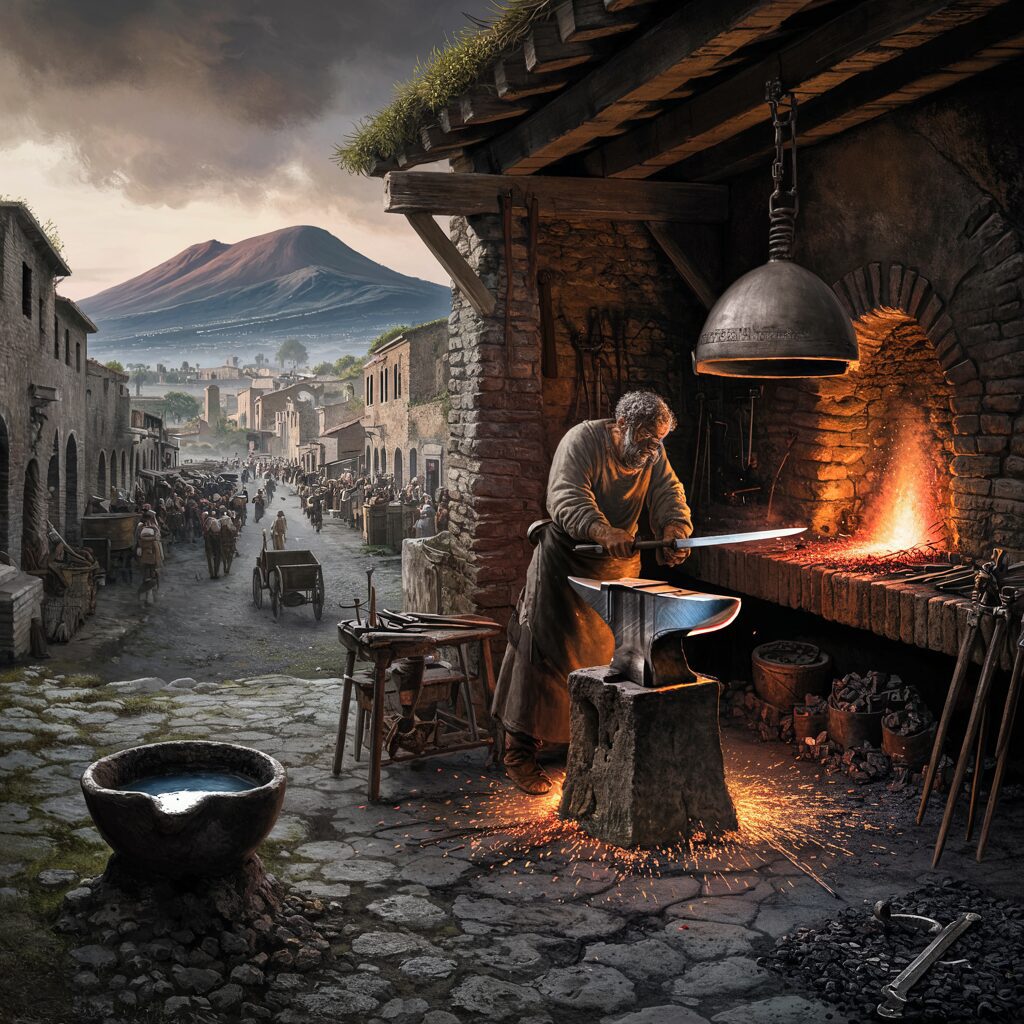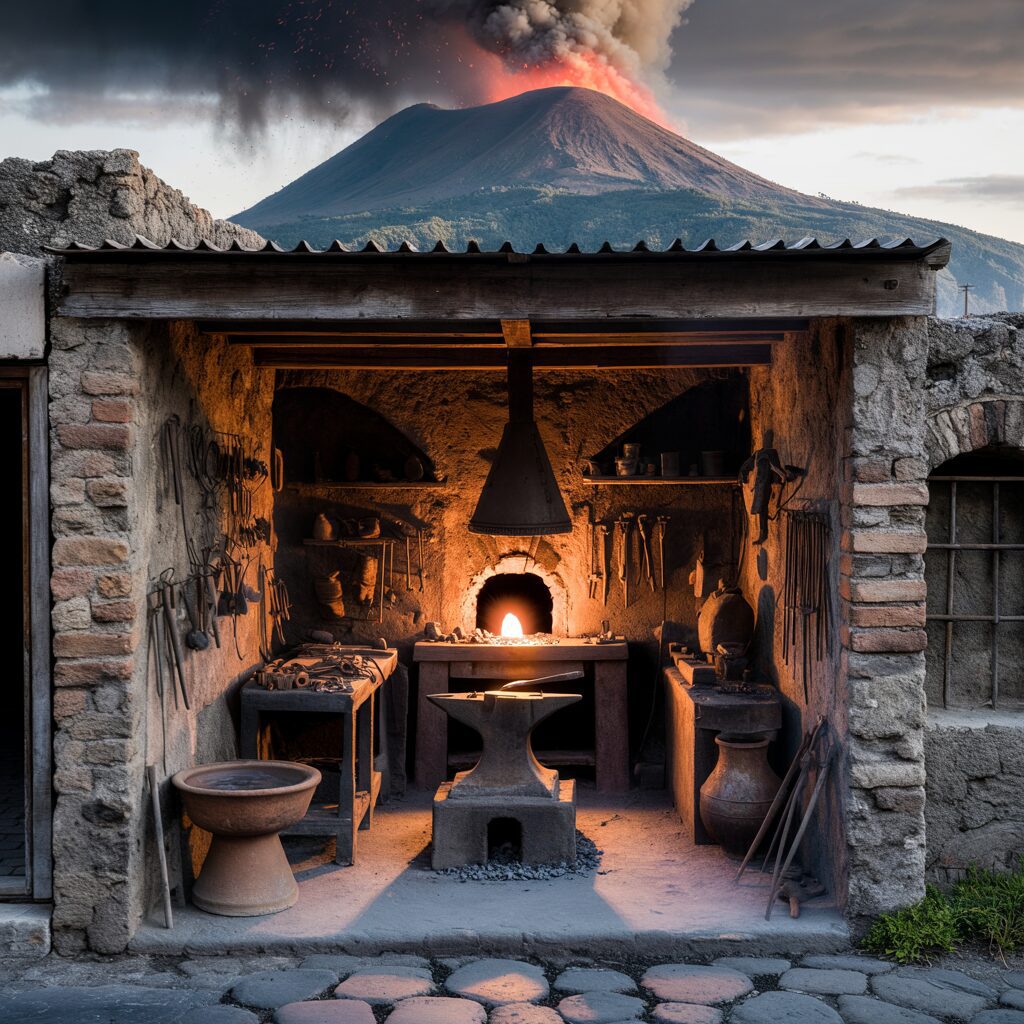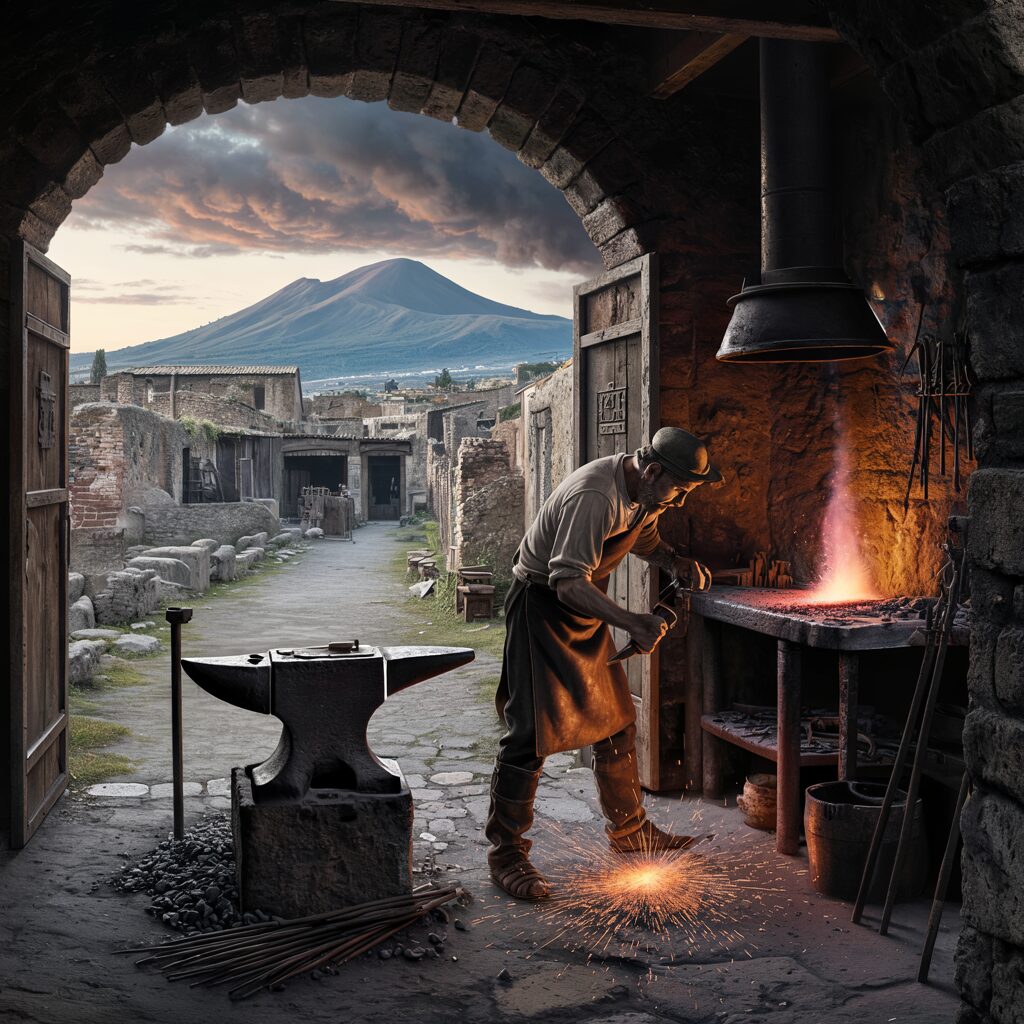Pompeii was a busy Roman city with a variety of economic activities supported by farming, trade, and different crafts. One of the key groups contributing to this economic strength were the blacksmiths and metalworkers of Pompeii, whose expertise benefited both everyday life and specific industries. These artisans created tools, hardware, and conducted repairs that kept the city’s infrastructure running smoothly.
The ever-present Mount Vesuvius loomed over Pompeii, a constant reminder of nature’s might and its impact on the lives of its people. Under this looming threat, blacksmiths and metalworkers diligently carried out their demanding tasks, playing a crucial role in a community striving for stability despite the unpredictability surrounding them.
This article delves into the lives of these craftsmen, exploring how Pompeii’s craft industries operated in this dynamic yet unstable setting leading up to the disastrous eruption of Vesuvius in AD 79.
The Economy of Pompeii: A Hub of Industries
Pompeii had a thriving economy supported by various industries that made the city lively and resilient. It wasn’t just a place where people lived, but also a busy center where trade and manufacturing came together.
What Industries Thrived in Pompeii?
Pompeii had several key industries that played a significant role in its economy:
- Agriculture and food processing: The production of olive oil, bread, and wine was crucial for local trade.
- Textile production: Weaving and dyeing workshops operated within neighborhoods.
- Metalworking: Blacksmiths and metalworkers crafted tools, household items, and construction materials essential for daily life.
- Pottery and ceramics: Workshops produced both functional and decorative pottery.
The Structure of Ancient Workshops
Unlike modern industrial areas, ancient workshops were usually small-scale operations located within residential neighborhoods. This setup allowed artisans to have direct contact with their customers, making it easier for them to do repairs or fulfill custom orders.
- Metalworking shops often occupied modest rooms fronting busy streets, making their services accessible to residents and passing traders alike.
- Weaving and dyeing workshops were integrated into the fabric of communities, allowing for efficient production and distribution of textiles.
The Interconnectedness of Industries
The presence of various industries in Pompeii demonstrates an adaptable urban economy that could respond to shifting needs. Blacksmiths not only produced tools but also supported other sectors dependent on metal products.
This interconnectedness ensured that workshops played a crucial role in the everyday economy of Pompeii.

Archaeological Evidence of Blacksmith Shops in Pompeii
Identifying blacksmith shops Pompeii relied heavily on careful archaeological methods, combining building layout analysis with artifact examination. Archaeologists focused on small rooms often adjacent to main streets, looking for features characteristic of metalworking spaces. Hearth bottoms or furnace remains provided clear signs of high-temperature activities essential to blacksmithing.
Key Archaeological Discoveries
Crucial archaeological finds include:
- Bits of metal and ore: These indicate raw materials processed on-site.
- Slag deposits: Waste from smelting and forging processes, slag helped confirm industrial activity.
- Hammer scale: Tiny flakes of oxidized iron produced during hammering, these microscopic particles settled on workshop floors and tools.
The presence of hammer scale is especially significant because it offers direct evidence of metal shaping and repair work, even when larger tools or anvils are missing from the site. By studying the spatial distribution of these materials within a building, archaeologists reconstruct the workflow and organization inside blacksmith workshops.
Artifacts Revealing Workshop Activities
Artifacts found alongside metalworking debris often include nails, horseshoes, or tools in various stages of manufacture or repair. This material culture reveals the essential role these workshops played—not only as production centers but also as service hubs supporting Pompeii’s infrastructure and daily life.

Case Study: Site VI,1 – Evolution of Industrial Spaces in Pompeii
Site VI,1 in Pompeii offers a vivid example of how industrial spaces transformed over time, reflecting the city’s shifting economic landscape. Archaeological excavations at this location revealed three distinct phases of use:
1. Early phase
The presence of large tanks lined with waterproof plaster points to an initial function related to wet industry. These tanks may have been used for activities requiring water containment, possibly dyeing or tanning processes.
2. Transition to blacksmith workshop
Later modifications converted the space into a blacksmith’s workshop. Evidence includes hearth bottoms for furnaces and scattered metallic residues such as slag and hammer scale. This phase highlights the growing importance of metalworking in supporting local infrastructure and daily needs.
3. Final conversion before AD 79
Prior to the eruption, the site was adapted into an inn or bar. This change indicates a shift from industrial production to hospitality services, perhaps responding to increased urban traffic or changing market demands.
The sequence of transformations at Site VI,1 encapsulates broader economic shifts within Pompeii. Industrial activities evolved alongside social dynamics, demonstrating adaptability in urban space usage. Blacksmiths and metalworkers occupied crucial roles during their tenure here, maintaining tools essential for construction and trade before commercial priorities redirected the site’s purpose toward serving visitors and residents alike.
This case study underlines how Pompeii’s urban fabric incorporated industrial functions that were not fixed but fluid, shaped by economic conditions that unfolded under the looming shadow of Mount Vesuvius.

Daily Life and Work of Blacksmiths and Metalworkers Under Vesuvius’ Shadow
Daily life for blacksmiths in Pompeii revolved around the metalworking process, a demanding craft requiring skill and precision. Their workshops were typically small, functional spaces equipped with a hearth or furnace where iron was heated until malleable. The work involved:
- Heating metal pieces to glowing temperatures.
- Hammering and shaping tools, nails, horseshoes, and household items on anvils.
- Quenching heated metal in water or oil to harden it.
- Repairing broken tools and creating new implements tailored to local needs.
Tool making and repair held critical importance for Pompeii’s infrastructure. Blacksmiths maintained agricultural implements, construction tools, and transportation hardware. Their craft supported the city’s roads, markets, homes, and farms, making daily life possible for both residents and businesses.
Interaction with the bustling streets meant blacksmiths were embedded in a network of tradespeople. Local farmers, builders, merchants, and artisans regularly visited workshops for custom work or urgent repairs. These exchanges fostered a sense of community reliance on metalworkers’ expertise.
Working under the looming presence of Mount Vesuvius added an unspoken urgency to their craft — every tool forged or mended was essential in sustaining a thriving city perched precariously beside a volatile giant.

The Role of Blacksmith Workshops in Pompeii’s Urban Fabric and Neighborhood Economy
Blacksmith workshops were strategically positioned along main roads within residential neighborhoods, making them accessible to local residents and passersby. This placement was no accident; urban workshops in Pompeii functioned as vital hubs embedded directly into the daily flow of city life, blending craft production with the rhythms of community interaction.
These workshops supported Pompeii’s infrastructure by producing and repairing essential tools used in construction, agriculture, and public maintenance. For example:
- Tool fabrication for builders working on homes, public buildings, and city walls
- Repair services for farming implements or household items
- Supplying iron fittings and hardware necessary for urban upkeep
Their contribution extended beyond mere utility. Blacksmiths held economic importance as providers of indispensable services that maintained the city’s physical and social framework. Residents relied heavily on these artisans not only for craftsmanship but also as part of a localized economy where goods and services circulated within neighborhoods.
These workshops fostered social ties through daily exchanges with customers, craftspeople, and neighbors. They became informal centers of economic activity where information about supply, demand, and market shifts circulated alongside the sparks flying from the forge. Urban workshops in Pompeii exemplify how metalworking was woven tightly into the fabric of communal life—both shaping and shaped by the city’s dynamic environment.
Challenges Faced by Archaeologists in Identifying Ancient Blacksmith Workshops
Identifying blacksmith workshops in Pompeii presents significant challenges due to the absence of complete tools or anvils. These essential items for metalworking were often removed, recycled, or decayed over time, leaving little direct evidence of the craft. This scarcity complicates efforts to distinguish blacksmith shops from other types of small industrial or domestic spaces.
The Role of Microscopic Evidence
Archaeologists rely heavily on microscopic evidence archaeology to overcome these difficulties. Key indicators include:
- Hammerscale flakes: Tiny metallic particles produced during forging that settle on workshop floors and surrounding areas.
- Slag fragments: Residue from smelting and refining processes.
- Ore remnants and metal bits: Leftover raw materials and scraps provide clues about the specific metals worked.
These microscopic traces can be detected with specialized equipment, revealing activity invisible through casual observation. Without such detailed analysis, many workshops would remain unidentified within Pompeii’s complex urban fabric.
The Significance of Hammerscale
The presence of hammerscale is particularly crucial. It acts like a fingerprint of metalworking activity, pinpointing locations otherwise indistinguishable from typical domestic or commercial rooms. This approach allows archaeologists to map the distribution and density of blacksmiths’ workshops within neighborhoods, offering valuable insight into Pompeii’s industrial footprint.
Such scientific methods deepen understanding of how metalworkers functioned daily, despite the passage of nearly two millennia since Vesuvius’ eruption sealed their world in ash.

Legacy of Pompeii’s Blacksmiths Amidst Natural Disaster: Insights into Ancient Craft Industries
The Vesuvius eruption AD 79 abruptly halted daily life in Pompeii, freezing workshops and their workers in time. Blacksmith shops, once bustling with activity, were buried under layers of volcanic ash and pumice. This catastrophic event became an unexpected preservative, capturing details of ancient craft industries that would otherwise have been lost.
- Volcanic ash sealed tools, raw materials, and remnants of metalworking processes within workshop spaces.
- Hearth bottoms and slag deposits remained undisturbed, offering a direct glimpse into the industrial practices of the time.
- Human figures near or within workshops provide poignant evidence of the workers’ final moments, emphasizing the human element behind these ancient crafts.
This level of preservation allows archaeologists to analyze blacksmithing techniques, workshop layouts, and material usage with remarkable clarity. The eruption’s destructive force paradoxically gifted modern researchers a uniquely detailed snapshot of Pompeii’s industrial heart, deepening understanding of how craft industries sustained urban life beneath the looming presence of Vesuvius.
Conclusion
Pompeii metalworkers significance lies in their integral role in shaping daily life under the shadow of Vesuvius. Their craft supported essential community needs—from tool production to infrastructure repair—embedding them deeply within Pompeii’s social and economic fabric. The preservation of workshops beneath volcanic ash offers a rare glimpse into the rhythms of ancient industrial life, enriching modern archaeological understanding.
Key takeaways:
- Blacksmiths and metalworkers were vital contributors to Pompeii’s diverse economy.
- Their workspaces reveal adaptive reuse reflecting economic shifts.
- Archaeological discoveries underscore the value of microscopic evidence in reconstructing lost crafts.
Pompeii’s Blacksmiths and Metalworkers: Daily Life in the Shadows of Vesuvius continues to illuminate these timeless human endeavors.

